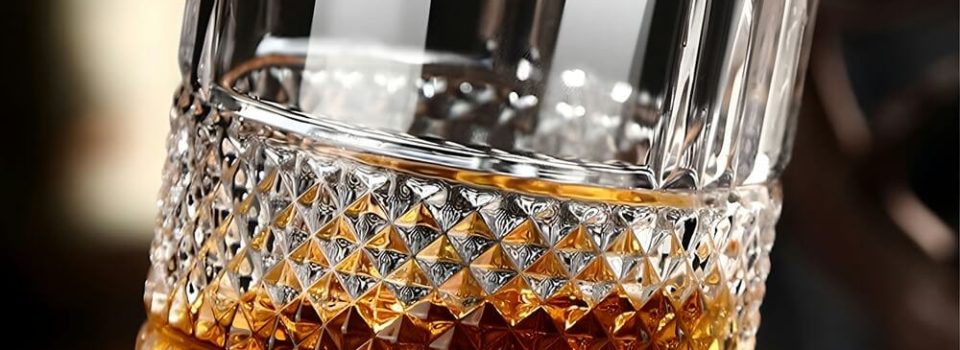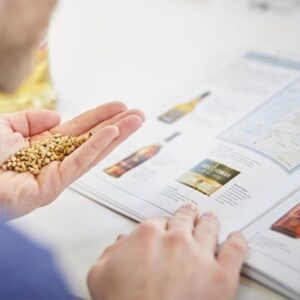If there’s one spirit that can spark as much passion as debate, it’s whisky.
Scotch, Irish, Japanese or American? Peated or fruity? Neat or with a drop of water?
This complex spirit — made from grain, water and a whole lot of patience — represents centuries of tradition, craftsmanship, and aromatic diversity.
For hundreds of years, whisky has fascinated drinkers around the world with its layered flavours and cultural richness.
But with so many styles — from Islay single malts to Kentucky bourbons or Japanese blends — it’s not always easy to find your way.
Let alone taste it with confidence or speak about it with precision.
Thankfully, there are now professional training programmes designed to structure your knowledge.
Among them, the WSET Spirits qualification, recognised worldwide, offers a clear, progressive, and universal method for understanding, tasting and talking about whisky — whether you’re a passionate enthusiast or a working professional.
In this article, we break it all down for you: from the origins of whisky to the different styles, the tasting techniques, and the best way to train with the internationally respected WSET Spirits course.
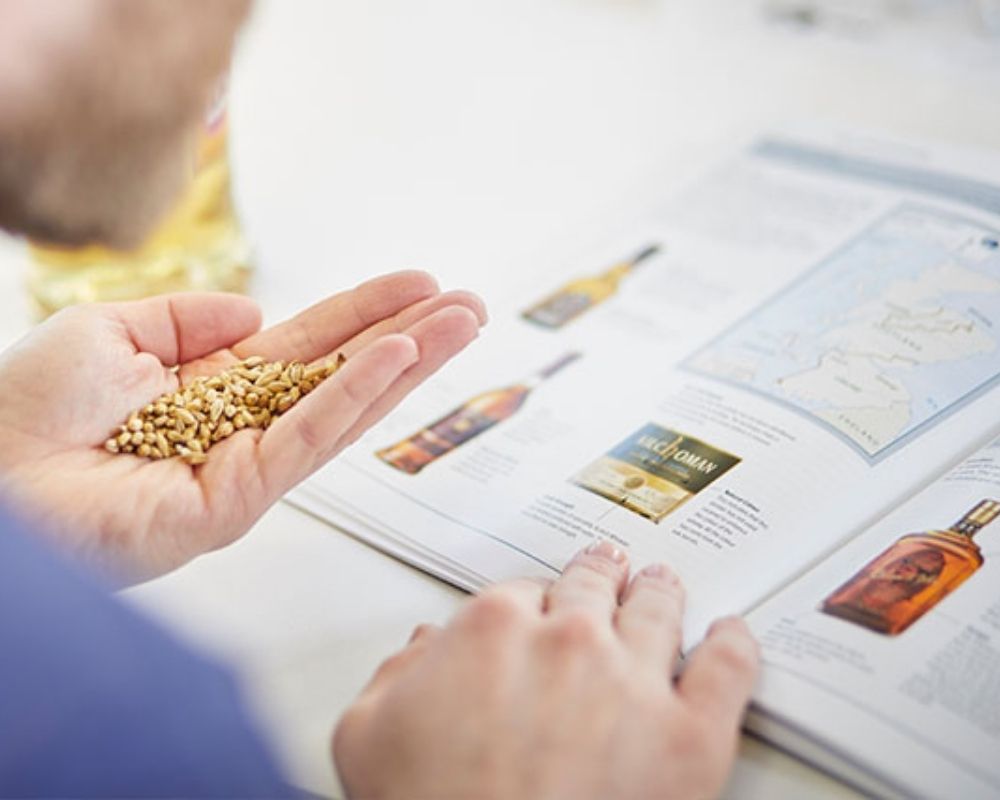
1. What Is Whisky? A Story of Grain, Fire and Patience
Whisky (or whiskey, depending on the country of origin) is a grain-based spirit aged in wooden casks.
But behind this simple definition lies a world of diversity, history, and craft.
Ancient Origins: Between Scotland and Ireland
The word “whisky” comes from the Gaelic phrase “uisge beatha,” meaning “water of life.”
The earliest written records of whisky distillation date back to 1494 in Scotland, but some historians believe that Irish monks introduced distillation as early as the 12th century.
For centuries, whisky was made in small batches, often informally. It wasn’t until the 19th century that whisky evolved into a structured industry — notably thanks to the invention of the Coffey still, which enabled continuous distillation, and the rise of blended whiskies.
Today, whisky is made all over the world — with emerging producers in Japan, India, Taiwan, France and beyond — contributing to a vibrant global whisky scene.
The Essential Ingredients of Whisky
A quality whisky always relies on three core ingredients:
- Grain: Barley, corn, rye or wheat — used alone or as part of a mash bill depending on the style.
- Water: Influences mouthfeel and minerality. Some distilleries highlight the purity of their water source.
- Yeast: Transforms sugars into alcohol during fermentation and plays a key role in shaping the final aroma.
The Key Steps of Whisky Production
- Malting: Grains (often barley) are soaked, germinated, and dried — sometimes with peat smoke.
- Mashing: The malted grain is crushed and mixed with hot water to extract sugars.
- Fermentation: Yeast converts the sugars into alcohol, creating a low-strength “beer.”
- Distillation: Typically double or triple distillation in copper pot stills or column stills, depending on the style.
- Aging: A minimum of 3 years in oak barrels — often ex-bourbon, sherry or wine casks.
- Blending & Bottling: Distillers may fine-tune the final product, adjust strength, or release single cask expressions.
A Strict Legal Definition
To be legally classified as whisky, the spirit must:
- Be distilled to no more than 94.8% ABV
- Be aged for at least 3 years in wooden casks (usually oak)
- Be bottled at a minimum of 40% ABV
Each producing country — Scotland, Ireland, the USA, and others — has its own regulatory framework, which shapes the style, labeling and identity of its whiskies.
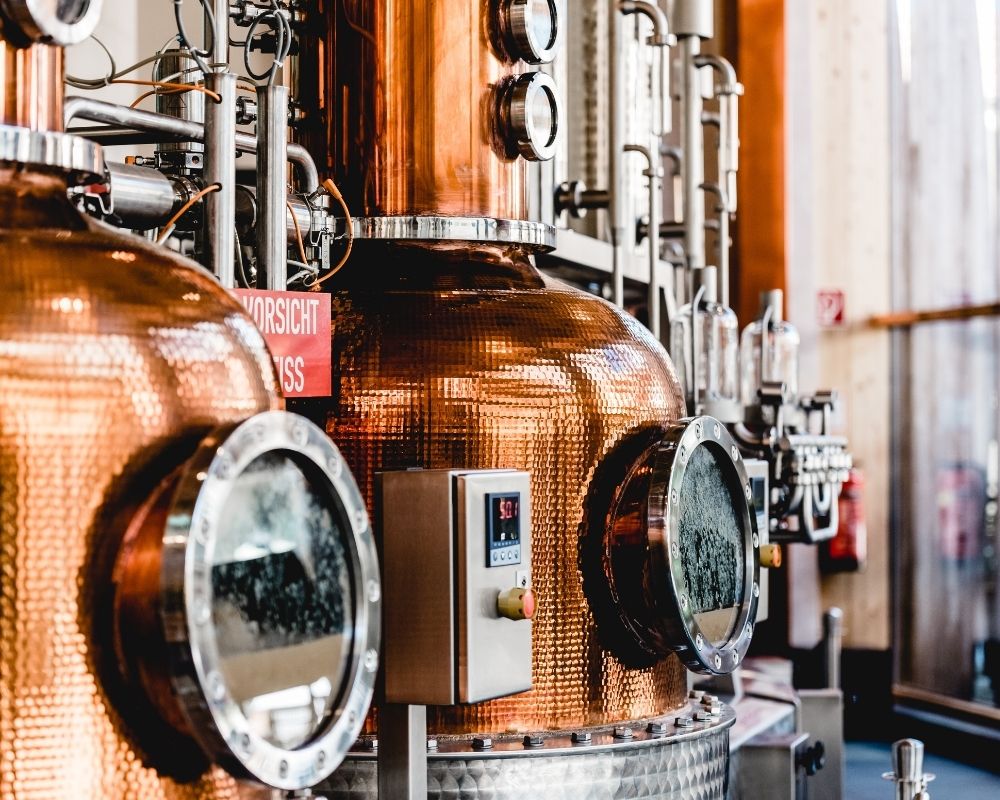
2. The Main Families of Whisky: Understanding the Iconic Styles
Whisky is a single category — but it encompasses a vast diversity of styles.
Each country, distillation method, and grain type gives birth to unique flavour profiles.
Let’s explore the key whisky families every enthusiast should know (and taste!).
Scotch Whisky (Whisky from Scotland)
One of the world’s most regulated and renowned whisky styles:
- Single Malt Scotch: Made from 100% malted barley, distilled at a single distillery in pot stills.
Examples: Glenlivet, Laphroaig - Blended Scotch: A mix of single malts and grain whiskies. Smoother, more accessible.
Examples: Johnnie Walker - Grain Whisky: Made from unmalted cereals (like corn or wheat), distilled in column stills.
Key Scotch regions include:
- Speyside: Fruity and elegant
- Islay: Peaty and smoky
- Highlands: Balanced and robust
- Lowlands: Light and floral
- Campbeltown: Complex and saline
Scotch is often aged in ex-bourbon or sherry casks, which strongly influence its flavour profile (notes of dried fruit, nuts, spice, vanilla…).
Irish Whiskey
Known for its smooth, floral profile, and often triple-distilled for extra refinement.
- Irish Whiskey: A blend of malted and unmalted barley, distilled in pot stills.
- Grain Whiskey: Often made with corn or wheat, distilled in column stills.
- Single Pot Still: A uniquely Irish style using malted + unmalted barley for added body and texture.
Key trait: Approachable and smooth — ideal for beginners.
Bourbon & Rye (American Whiskeys)
The U.S. has strict regulations, just like Scotland — and some of the boldest whisky styles.
- Bourbon: Made from at least 51% corn, aged in new, heavily charred American oak barrels.
Rich, sweet, with notes of vanilla, caramel, and toasted oak.
Examples: Maker’s Mark, Buffalo Trace - Tennessee Whiskey: Like bourbon, but filtered through charcoal (the Lincoln County Process).
Example: Jack Daniel’s - Rye Whiskey: Made from at least 51% rye. Spicier, drier, and more assertive.
Example: Bulleit Rye
Key trait: New oak barrels deliver intense flavour fast — expect vanilla, coconut, and caramel.
Japanese Whisky
Inspired by Scottish traditions — but with a distinctly Japanese aesthetic.
- Japanese Single Malts: Pure, refined, and often delicately floral or subtly peated.
Examples: Yamazaki, Hakushu - Blended Japanese Whisky: Complex and carefully constructed, sometimes using imported spirit.
Philosophy: Precision, harmony, and craftsmanship — down to the barrel wood (like rare Japanese Mizunara oak).
Whisky from Around the World
- Canada: Often rye-based, light-bodied, and widely used in blends.
- India: A rising star in the whisky world, with distilleries like Amrut and Paul John producing award-winning expressions.
- France, Taiwan, Sweden…: Non-traditional whisky countries now create high-quality craft whiskies.
Unique trait: In hot climates like India and Taiwan, whisky ages faster, often resulting in intense, concentrated flavour and a different texture.
💡 Want to explore another spirit?
Check out our full guide to everything you need to know about rum!
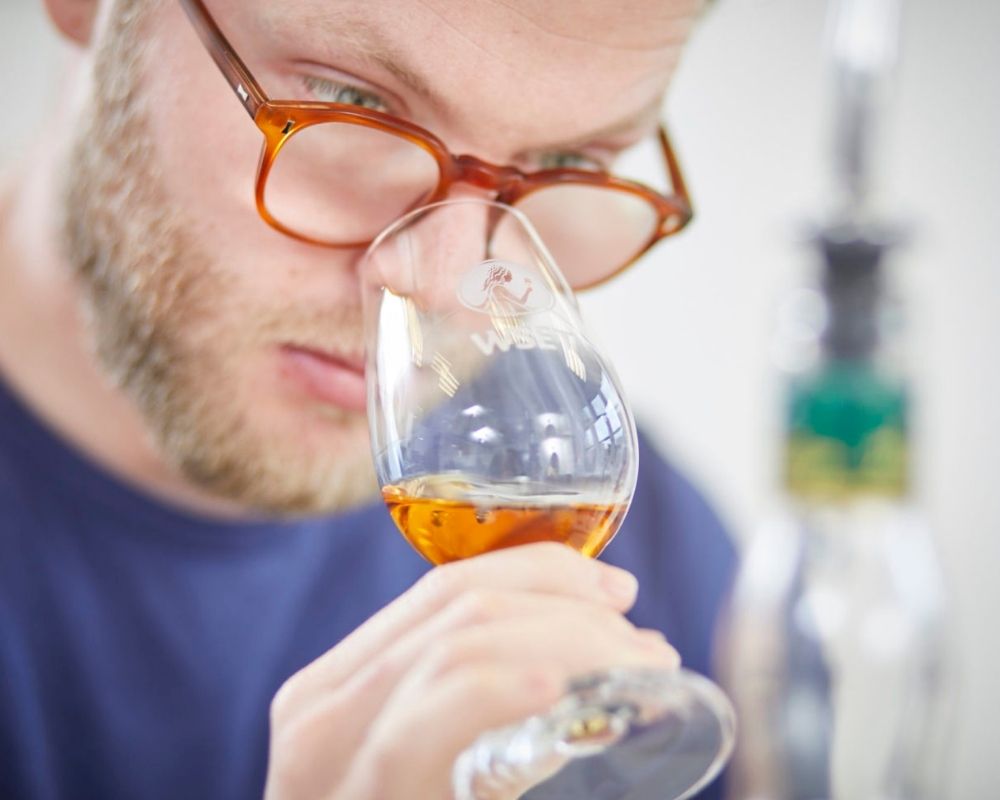
3. How to Taste Whisky Like a Pro
Behind every sip of whisky lies an incredible depth of aromas and flavors.
But to truly appreciate it, you need the right tasting method.
At Weeno, we teach the WSET® Systematic Approach to Tasting (SAT) — a clear, structured, and reproducible method used by professionals around the world.
Here’s how to apply it to whisky:
Visual Examination: Assessing Appearance
- Color: Pale gold? Deep amber? Mahogany?
The hue gives clues about ageing and cask type (e.g. sherry casks = darker tones). - Legs (or tears): These hint at viscosity — and therefore alcohol and potential sweetness.
👉 Weeno Tip: Don’t rely solely on color — many whiskies are colored with caramel (E150a).
On the Nose: Smelling the Aromas
- First, smell without swirling the glass — this captures the most volatile aromas.
- Then gently swirl to release heavier notes.
Look for:
- Fruits: fresh, dried, or stewed
- Spices: pepper, cinnamon, clove
- Grains & malt
- Wood: vanilla, coconut, tobacco
- Peat: smoky, medicinal
- Oxidative notes: nuts, sherry, rancio
👉 Weeno Tip: Keep your mouth slightly open while nosing — this reduces alcohol burn and enhances aroma perception.
On the Palate: Texture, Flavor, Balance
- Attack: Is it smooth? Sharp? Oily?
- Development: What flavors emerge? Do they match the nose or evolve?
- Finish: Long or short? Dry, sweet, bitter?
You’ll assess:
- Balance (between alcohol, flavors, and mouthfeel)
- Aromatic intensity
- Complexity (the range and layering of flavors)
- Perceived quality
👉 Weeno Tip: Add a few drops of water (less than the whisky’s volume) to “open up” the aromas and reduce palate fatigue — especially after multiple tastings.
Blind Tasting: A Core WSET Skill
WSET trains you to evaluate whisky blind, focusing on objective markers (aromas, texture, structure) — not the label, brand, or price.
Common Tasting Pitfalls
- Believing older = better (age doesn’t guarantee quality)
- Judging by brand or price tag alone
- Using peatiness as the only quality indicator
- Tasting in poor conditions (noise, distractions, strong smells)
In Short: Learning to Taste = Learning to Understand
Good tasting means reading the glass —
Understanding what you’re smelling, tasting, and why.
That’s exactly what you’ll master in the WSET Spirits qualifications.
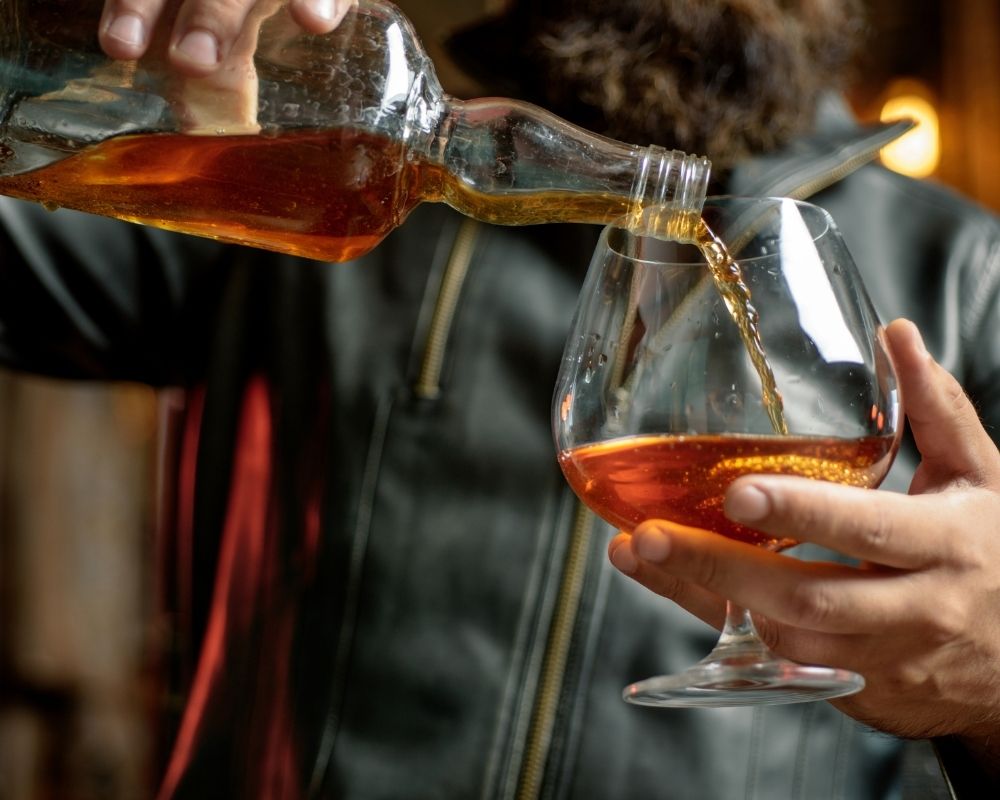
4. Food & Whisky Pairing: Surprising (and Delicious) Combinations
When it comes to food pairing, people often think of wine or beer…
But whisky? It’s still one of the most underrated players at the dinner table.
And yet, with its intense aromas, complexity, and richness, whisky can elevate a meal — if you know how to pair it right.
Here are the golden rules of whisky & food pairing, as taught in WSET Spirits courses:
Match Intensity with Intensity
Whisky is a high-proof spirit (40%+ ABV) with strong, bold flavors.
That’s why you should:
- Avoid delicate dishes — they’ll get overwhelmed.
- Focus on bold-flavored foods: smoked meats, aged cheeses, rich desserts.
Example: A peated Islay single malt + smoked meat or game = flavor explosion with perfect balance.
Play with Contrasts
Whisky aromas can either complement or contrast with food flavors:
- Peated whisky + sweetness: smoky notes pair beautifully with dark chocolate or vanilla-based desserts.
- Oaky spice + saltiness: a toasty bourbon matches grilled bacon or blue cheese.
- Light fruitiness + acidity: a fruity Lowland Scotch works well with ceviche or candied citrus.
Classic Pairings That Always Work
| Whisky Style | Perfect Food Match |
| Peated Scotch (Islay) | Oysters, smoked salmon, 85% dark chocolate |
| Fruity Single Malt (Speyside) | Blue cheese, pear tart, foie gras |
| Bourbon (vanilla & spice) | BBQ pork ribs, grilled corn, pecan pie |
| Japanese Whisky (elegant) | Sushi, sashimi, yuzu cheesecake |
| Rye Whiskey (dry & spicy) | Pastrami, smoked charcuterie, spiced cake |
Don’t Overpower with Alcohol
The goal of a pairing is harmony, not heat.
Keep in mind:
- Consider slightly diluted whisky or add a few drops of water.
- Serve smaller pours.
- Keep it room temp or slightly chilled — never too warm.
👉 Weeno Tip: Whether at aperitif or dessert, whisky can stand in for wine — just adjust the quantity and intensityaccordingly.
Want to learn how to pair like a pro?
WSET Spirits certifications include pairing techniques that take your whisky appreciation to the next level.
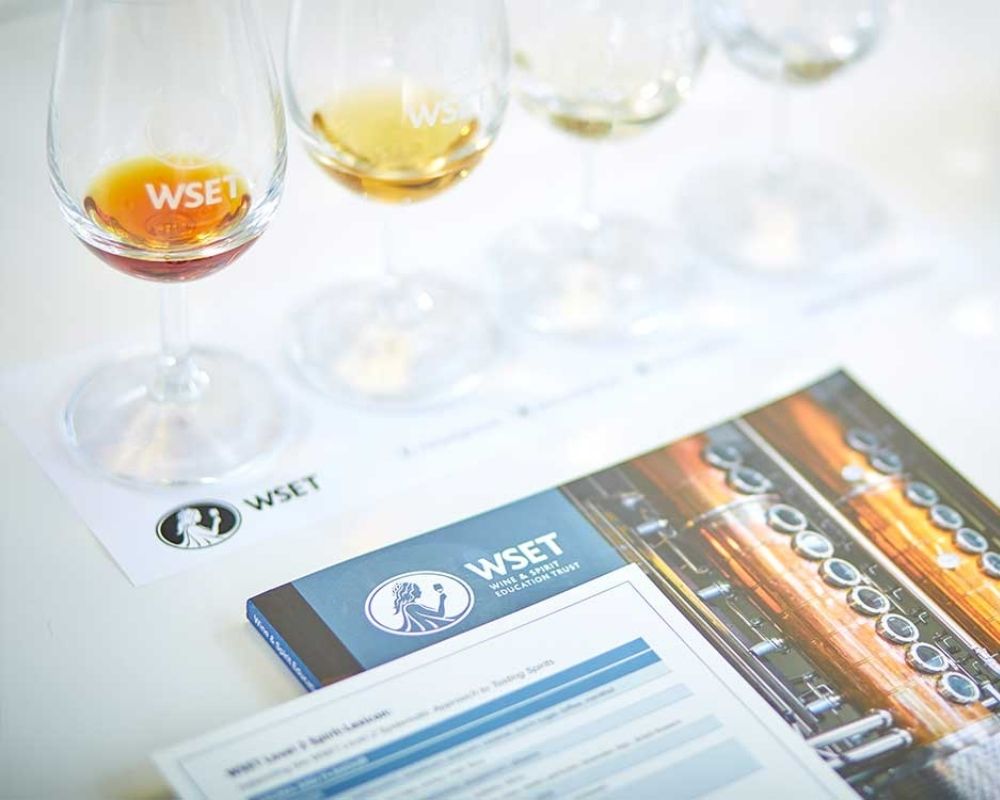
5. Why Study Whisky with the WSET?
You love whisky and want to go beyond casual tastings with friends?
You work in the hospitality industry, or you’re ready to take your passion to the next level?
The WSET Spirits qualification is the gold standard for developing in-depth, structured, and globally recognized knowledge of whisky.
An Internationally Recognized Certification
The WSET (Wine & Spirit Education Trust) is the world’s leading provider of alcohol education. Its rigorous and progressive method is taught in over 70 countries.
With the WSET Spirits qualification, you earn a diploma that is:
- Recognized by industry professionals (bars, hotels, retail, brands, etc.),
- A strong addition to your CV or entrepreneurial project,
- A true mark of credibility and expertise in front of clients or business partners.
A Structured Way to Really Understand Whisky
Whisky is about much more than taste or branding.
To fully grasp it, you need to understand:
- The ingredients and how they impact the flavor (grains, water, yeast),
- Distillation and aging methods,
- Stylistic differences by country (Scotland, Ireland, USA, Japan…),
- Quality factors, potential faults, and aromatic influences.
That’s exactly what the WSET Spirits Level 1, Level 2, and Level 3 offer — a deep dive into whisky and beyond.
A Professional Tasting Method
WSET teaches a unique, professional tasting method: the Systematic Approach to Tasting® (SAT).
You’ll learn how to:
- Break down a whisky through sight, nose, palate, and finish,
- Identify key styles and flavor profiles,
- Spot quality indicators or flaws,
- Put the right words to what you taste,
- Speak about whisky with clarity and confidence.
Practical Tools for Real-Life Use
Whether you’re a:
- Bartender, sommelier, or spirits shop manager,
- Career changer,
- Spirits entrepreneur,
- Or a curious enthusiast…
The WSET gives you practical tools to:
- Recommend products with precision,
- Lead tastings and training sessions,
- Buy, sell, and speak about whisky more effectively,
- Launch your own venture (bar, brand, club, tasting events…).
A Holistic View of the Spirits World
WSET Spirits training isn’t limited to whisky.
You’ll gain a broader understanding of:
- Other major spirits: rum, gin, vodka, tequila, cognac, armagnac, and more,
- Global production trends,
- Food & cocktail pairings,
- Innovation and mixology.
Because a true whisky expert is also a well-rounded connoisseur of flavor.
👉 Want to learn more? Check out our article on the WSET Level 3 in Spirits to find the program that fits you best.

6. Why Study Spirits with the WSET at Weeno?
At Weeno, we train both passionate enthusiasts and demanding professionals with a rigorous, friendly, and accessibleapproach to spirits education.
It’s no coincidence that more and more students choose Weeno to truly learn how to talk about spirits — especially whisky — with confidence.
A Recognized Expertise in WSET Training
From the very beginning, we’ve specialized in WSET qualifications: wine, spirits, beer, and sake.
- 100% pass rate for WSET Level 2 in Wines in 2023
- 78% pass rate for theory, and 98% for tasting in WSET Level 3 Wines
- Among the first centers in France to offer WSET Spirits Levels 1, 2 & 3 — and now WSET Beer Levels 1 & 2 as well!
Certified, Passionate, and Committed Instructors
At Weeno, you don’t just learn from anyone.
Our educators are:
- WSET-certified professionals,
- With real-life experience in bars, brands, tastings, and consulting,
- And above all: they teach with passion, clarity, and kindness.
You’ll progress at your own pace, ask all your questions, and learn in a pressure-free, yet high-standard environment.
A Clear, Practical, and Interactive Method
- Small groups (max 14 students) to encourage dialogue
- Visual and practical course materials
- Comparative tastings of whiskies (Scotland, Ireland, USA…)
- Quizzes, games, and real-world case studies to learn without boredom
- Personalized tips to pass your exam or support a career shift
Flexible Format: Online or In Person
You can choose to study WSET Spirits:
- In Paris or Marseille, in our warm and welcoming training spaces
- Or fully online, with 24/7 access to all learning materials for 1 full year
The online format includes:
- Video lessons, study sheets, quizzes, and flashcards
- Access to a student community
- Final exam in-person in Paris or Marseille
Eligible for CPF Funding (Under Certain Conditions)
Thanks to our partnership with CLOE and LTE certifications, our bilingual or English-based WSET courses may be funded via CPF (France’s personal training account system).
How it works:
- You enroll in your WSET Spirits course (Level 1, 2, or 3) in French or English
- You join professional English workshops focused on spirits (CPF-eligible)
- You take both your WSET exam + an English language test (CLOE or LTE)
🎓 Result: double certification!
- A WSET Spirits diploma
- A professional English certification, highly valued in today’s job market
A Professional, Yet Friendly Atmosphere
At Weeno, you don’t just attend a course —
You join a passionate community united by:
- A curiosity for flavor
- A drive to understand deeply
- A shared professional standard
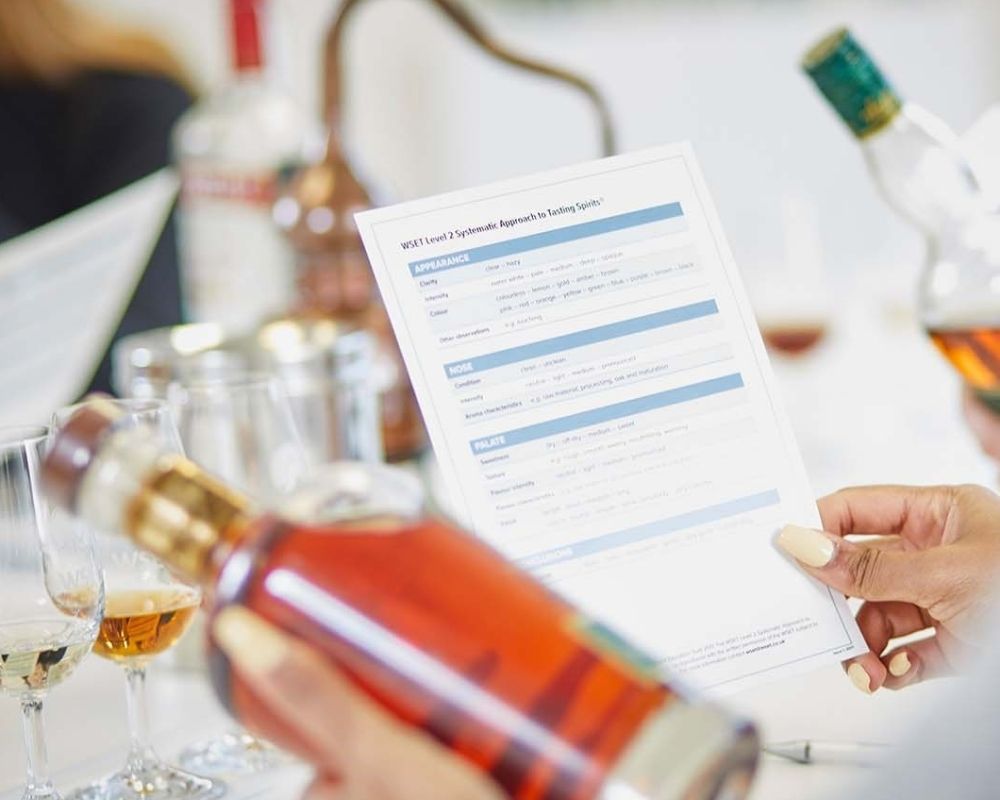
Whisky: A Rich World… Truly Worth Exploring
Understanding whisky is about so much more than knowing if it’s Scotch or Japanese.
It’s about learning how to:
- Decode labels with confidence
- Identify different styles and regional nuances
- Recognize aromas — and detect faults
- Create unexpected (but amazing) food & whisky pairings
- And above all… speak about whisky with clarity, passion, and credibility
Whether you’re a curious enthusiast, a hospitality professional, a wine & spirits merchant, or building your own drinks-related business…
Studying with the WSET Spirits certification gives you a strong, lasting, internationally recognized foundation to:
- Talk about whisky like a pro
- Taste it mindfully and with precision
- And simply enjoy it more — with knowledge and purpose
And at Weeno, we help you do it seriously… without taking ourselves too seriously.
👉 Curious about the WSET Spirits course?
Check out all upcoming sessions now at weenodrinksacademy.com
